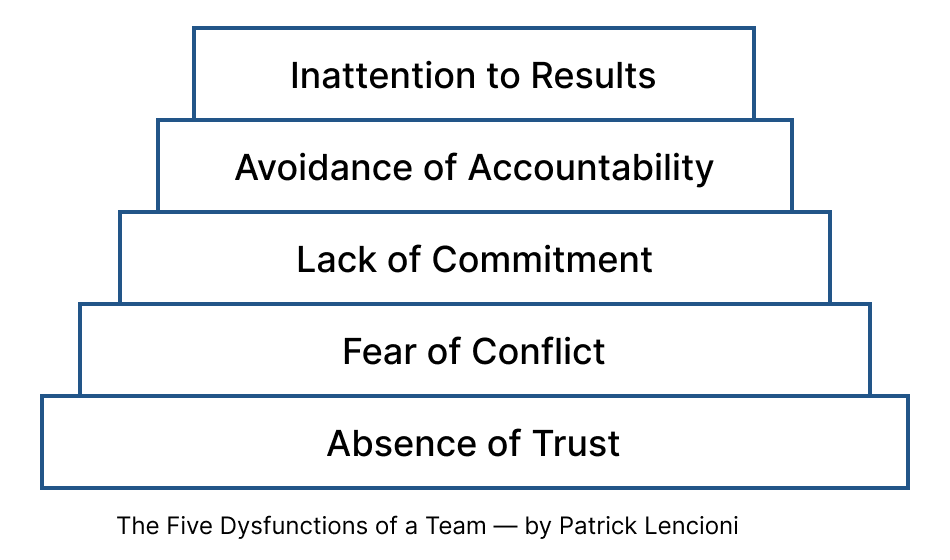How Five Dysfunctions are Ruining Teams and Companies
Insights from the book ‘Five Dysfunctions of a Team’ by Patrick Lencioni
What is your take on conflicts at work?
Preventing conflicts is not healthy. Pleasing everyone will not help us get what we want. When we avoid conflicts we turn off the opportunity to exchange different points of view.
As a manager, I was wrong to ensure that my work environment minimised conflicting situations. This is one of the dysfunctions of teams.
Conflicts are good when focused on solving problems and not blaming or judging people.
In this post, we will explore insights from the book ‘'The Five Dysfunctions of a Team'.
Five Dysfunctions
Patrick Lencioni proposed these dysfunctions to address:
Absence of Trust
Fear of Conflict
Lack of Commitment
Avoidance of Accountability
Inattention to Results
Trust is the baseline of the model, and each dysfunctions build on top of another:
Absence of Trust
Can people be open about their weaknesses just as much as their strengths?
Defining weaknesses and being open within the team is important. This way we lower the bar for being wrong.
You are a leader, and everyone is just nodding and agreeing. What is more probable: you always have brilliant ideas? Or they don't want to disagree with you because of your position? (and lack of trust)
Being open to admitting mistakes is an important aspect of growing organisations. More on this in the article ‘On Making Mistakes’.
Fear of Conflict
Do you fear conflict?
First, build trust, then be open to conflicts.
Respectful disagreement, detached from personal accusations and focused on discussing ideas and solutions, is the right approach.
Let people be heard and try to understand their points of view, even if they conflict with each other. In the end, a decision has to be made. However, if people feel they had the opportunity to openly express their opinions, it is possible to disagree and still commit.
What if a team of engineers does not raise their concerns about the solution picked by the most senior one, just to keep the atmosphere friendly? It is not friendly behaviour to stay silent if a project will suffer.
“The vast majority of companies have far too little good conflict. Because we live in a society now, that says, disagreeing with somebody is inappropriate.”
— Patrick Lencioni
Lack of Commitment
Imagine engineers who privately express their doubts about the timeline, but do not state that during the team's call. In such circumstances, the team is not fully committed to delivering, and missing the deadline is just a self-fulfilling prophecy.
To ensure that people are committed, involve them in the decision-making process and make them understand the company's goals. The more a team's incentives are not aligned with the common objectives, the more difficult it is to commit. Read more about this in the article ‘Mastering Incentives at Work’.
Avoidance of Accountability
In team sports, each player knows their responsibilities and holds other team members accountable. This is the kind of commitment we need at work. Each time you defend your colleagues and ignore their underperformance because you like them, it slowly erodes the team's performance.
Making sure that team members know their responsibilities is important for promoting accountability within the team.
It is not just the leader's job to ensure commitment. When team members understand their common goal, they can hold themselves accountable. This is similar to sports, where team members must know their roles and strategies to win the game.
Inattention to Results
It is not about individual scores, but the results of the whole team, or the whole company.
Some organisations focus on measuring people’s inputs, such as tracked hours of work or office attendance, rather than their outputs — the results of their work. My hypothesis is that in an organisation built on trust, where these five dysfunctions are minimised, there is no need to measure inputs. Pay attention to outcomes, not inputs.
The book explores the concept of prioritising the teams we are part of. It emphasises that the highest-ranked team within the organisation should be considered our main and most important team. In the fictional story presented in the book, this team was the company's board. However, it highlights that the C-level executives tended to prioritise their teams over the shared goals of all C-level executives.
Summary
If you are in a position to:
build trust
change perspective on having conflicts
show that it is possible to commit even if you disagree
understand responsibilities and hold people accountable
focus on team results
Be an example worth copying and act to avoid team dysfunctions.
Trust is the baseline to overcome five presented dysfunctions. Without it, the success of the organisation might be out of reach. Watch for the moments when you stop yourself from stating your opinion or pretending to be someone you are not. Meetings are a great place to observe and analyse the mentioned dysfunctions.
Thanks for reading!
Michał
PS: You can listen to an interview and discussion on these dysfunctions in the Elevate podcast — #261.
Post Notes
Discover Weekly — Shoutouts
Articles that might help you explore new perspectives, which I have read recently:
"Get To Know People" from
— presented how getting to know people can build trust, and how small talk is more important than we think.“That Extra Focus on Solution is Hurting Your Leadership” from
— shares rich stories on how to be a better team leader who is focused on growing their team, not just giving orders."Locationscout - From idea to 140,000 users." from
— interviewed providing an amazing story of the growth of Locationscout.net, developed by a one-man army.Engineer handled an incident at a barber shop from The Curious Soul's Corner —
wrote a great reminder about the concept of Extreme Ownership.



